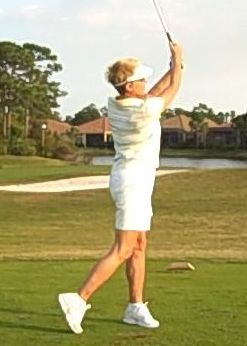August 23, 2021
Learning to Play Golf
 When learning the game of golf, the first fundamental is a basic understanding of the objective of the game. That objective is to propel the golf ball from the teeing ground and into the hole in the fewest number of strokes. The method used to accomplish this task are properly constructed and fitted golf clubs and an effective golf swing that can strike the ball to make it go the required distance.
When learning the game of golf, the first fundamental is a basic understanding of the objective of the game. That objective is to propel the golf ball from the teeing ground and into the hole in the fewest number of strokes. The method used to accomplish this task are properly constructed and fitted golf clubs and an effective golf swing that can strike the ball to make it go the required distance.
After obtaining the proper golf clubs for your particular skill level, you then need to learn to hit the golf ball. Proper instruction from a trained professional is vital to your development as a proficient golfer. When learning to play golf, many students become fixated on the golf swing. Remember, the golf swing is not golf. What the golf swing is, is a tool that is needed to perform the necessary objectives of the game. That said, it is also important to state that the better the tool (golf swing) the greater the options and potential.
There are three stages that golfers work through in becoming accomplished players. They are the Learning Mode, Trusting Mode and the Playing Mode. Each is different in purpose and intent. Although each is an important step in the development of a player, they should not be mixed.
The Learning Mode is what we use to learn a new skill or refine an existing one. In this mode the mind is active, inquisitive, evaluative, judgmental, critical and impatient. We set standards and rely on tactile feedback to accomplish our goals. In this learning mode the concentration is on specific body positions and the feel that these new positions produce. When learning a new swing the student should NOT be target oriented or judged on ball results. What is important, is developing the new skill.
Once the Learning process has progressed to a comfortable point, then a target can be introduced. The mind needs to switch to the Trusting Mode. In this mode the mind is passive and nonjudgmental. You "Let Go" and "Let it Happen".
Follow a set routine and center in on your target and visualize the desired result. Patience is very important in the early stages of this mode. If the ball doesn't produce the desired result, the natural tendency is to immediately go back to the Learning Mode. You will NEVER become an accomplished player if you continue to constantly relearn what you already have learned! If, after a period of time, you are not producing the expected outcome, then you should reevaluate your technique. Switch back to the learning mode. This must be a conscious decision. Target is not in the equation. Once your mind and body are satisfied with the results, then switch back to the Trusting Mode. Do not mix the two. If you do, you will be stuck in a never-never land and will not play up to your potential.
In the Trusting Mode the main focus is "letting go" of physical thoughts and visualizing the ideal shot toward a specific target. That is the primary focus, but we have many focuses at any given time. These soft focuses or secondary focuses include all the senses of touch, smell, sight, hearing, and taste. Kinesthetic, vestibular and visceral senses are also being monitored. In other works, we are aware of many different stimuli each moment of our lives. Our concentration can be centered on one specific goal, but we are also sensitive to the weather, noise, movement, people, and internal feelings. Once the shot has landed, the student and teacher can evaluate the results. The student in regards to accomplishing his task, trusting the swing and keeping in the visual and being target oriented. The teacher will measure the freeness and smoothness of the swing and the physical positions of the body and club. Questions like, "What did that feel like?" or "Did you feel that or visualize that?", are queries addressed to the student in the Trusting Mode. In the trusting mode the student MIGHT be able to ascertain club positions or body positions, but usually it is a feeling that something is different. In the Trusting Mode, being aware of exact positions in the swing is counterproductive.
The reason why we have worked so hard in building a swing that can be trusted, is to use it on the golf course. This is the Playing Mode. This mode mixes cognitive decision making, a habitual sequence process, and a trusted response. The mind is passive, nonjudgmental and visually oriented. The Playing Mode requires that the Left Brain be involved with the decision making of each shot. These decisions include calculating distance, wind, direction, lie conditions, obstacles and hazards, risk/rewards, target, alignment, swing and club choice and shot selection. Following the "Pre-Shot Routine" the left brain passes the responsibility to the Right Brain to accomplish the task. Physical swing positions can be thought about and practiced prior to committing to a "plan of action." Once the decision has been made and the visualization process has started, there are no longer conscious mechanical thoughts. Playing golf can be likened to a symphony. You set a rhythm and follow the flow of the music. When playing a musical instrument or playing golf, your concentration is to remain in the present, stay in the flow and accomplish the task.
"What the mind believes, the body will achieve." "Wild Bill" Melhorn



